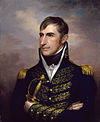It has been requested that the title of this article be changed to List of governors of Indiana . Please see the relevant discussion on the discussion page. The page should not be moved unless the discussion is closed; summarizing the consensus achieved in support of the move. |

The Governor of Indiana is the chief executive of the U.S. state of Indiana. The governor is the head of the executive branch of Indiana's state government and is charged with enforcing state laws.

The Governor of Indiana is the chief executive of the state of Indiana. The governor is elected to a four-year term, and responsible for overseeing the day-to-day management of the functions of many agencies of the Indiana state government. The governor also shares power with other statewide executive officers, who manage other state government agencies. The governor works out of the Indiana Statehouse and holds official functions at the Indiana Governor's Residence in the state capital of Indianapolis.
Head of government is a generic term used for either the highest or second highest official in the executive branch of a sovereign state, a federated state, or a self-governing colony, who often presides over a cabinet, a group of ministers or secretaries who lead executive departments. The term "head of government" is often differentiated from the term "head of state", as they may be separate positions, individuals, or roles depending on the country.

In the United States, a state is a constituent political entity, of which there are currently 50. Bound together in a political union, each state holds governmental jurisdiction over a separate and defined geographic territory and shares its sovereignty with the federal government. Due to this shared sovereignty, Americans are citizens both of the federal republic and of the state in which they reside. State citizenship and residency are flexible, and no government approval is required to move between states, except for persons restricted by certain types of court orders. Four states use the term commonwealth rather than state in their full official names.
Contents
While a territory, Indiana had two governors appointed by the President of the United States. Since statehood in 1816, it has had 49 governors, serving 51 distinct terms; Isaac P. Gray and Henry F. Schricker are the only governors to have served non-consecutive terms. Four governors have served two four-year terms; territorial governor William Henry Harrison served for over 12 years. The shortest-serving governor is Henry Smith Lane, who served two days before resigning to become a U.S. Senator. The current governor is Eric Holcomb, who took office on January 9, 2017.

Isaac Pusey Gray was the 18th and 20th Governor of the U.S. state of Indiana from 1880 to 1881 and from 1885 to 1889. Originally a Republican, he oversaw the forceful passage of the post-American Civil War constitutional amendments whilst he was a member of the Indiana Senate. He became a Democrat following the corruption of the Administration of Ulysses S. Grant but was regularly stymied by his Democratic adversaries who constantly referred to his tactics while a Republican, earning him the nickname "Sisyphus of the Wabash."

Henry Frederick Schricker was the 36th and 38th Governor of the U.S. state of Indiana from 1941 to 1945 and from 1949 to 1953. He is the only Indiana governor elected to two non-consecutive terms, and the only governor between 1852 and 1977 to be elected to more than one term in office. His terms were marked by strong opposition party control of the Indiana General Assembly, which attempted to remove powers from the governor that had been granted during the Great Depression. Schricker fought the attempt in the state courts, and although his power was significantly reduced, the Indiana Supreme Court ruled in the case of Tucker v. Indiana that the governor was the chief executive of the state, and the legislature could not pass legislation that interfered with the division of powers.

William Henry Harrison was an American military officer and politician who served as the ninth president of the United States in 1841. He died of typhoid or paratyphoid fever 31 days into his term, becoming the first president to die in office. His death sparked a brief constitutional crisis regarding succession to the presidency, as the Constitution was unclear as to whether Vice President John Tyler should assume the office of President or merely execute the duties of the vacant office. Tyler claimed a constitutional mandate to carry out the full powers and duties of the presidency and took the presidential oath of office, setting an important precedent for an orderly transfer of presidential power when a president leaves office.






















































